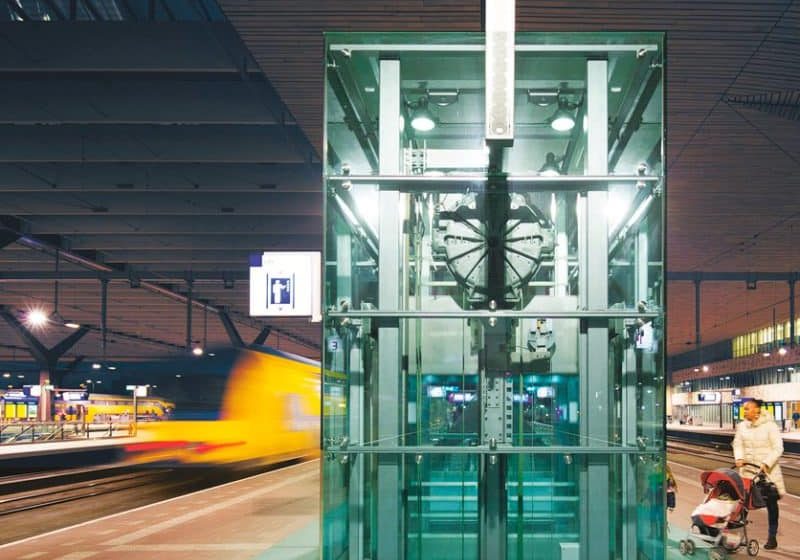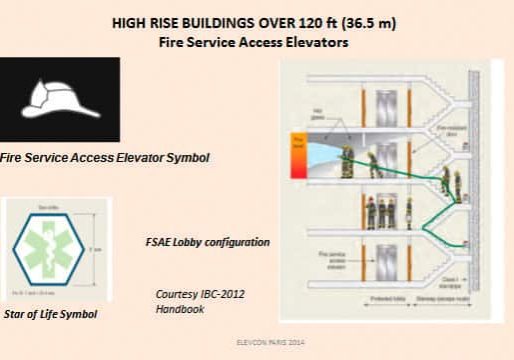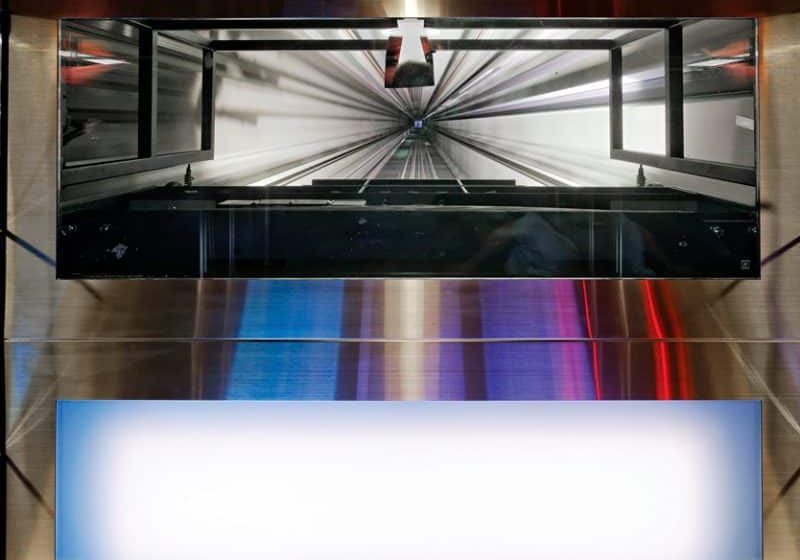This paper was presented at  Paris 2014, the International Congress on Vertical Transportation Technologies, and first published in IAEE book Elevator Technology 20, edited by A. Lustig. It is a reprint with permission from the International Association of Elevator Engineers
Paris 2014, the International Congress on Vertical Transportation Technologies, and first published in IAEE book Elevator Technology 20, edited by A. Lustig. It is a reprint with permission from the International Association of Elevator Engineers  (website: www.elevcon.com). This paper is an exact reprint and has not been edited by ELEVATOR WORLD.
(website: www.elevcon.com). This paper is an exact reprint and has not been edited by ELEVATOR WORLD.
Abstract
As the world economy continues to grow more global in nature, the demand for innovative products accelerates. The competition in ideas enhances consumer value in terms of safety, quality and performance. The Machinery and Lifts Directives spawned a wave of innovation in the elevator industry and inspired ISO to create documents and processes that could be widely adopted in order to support innovation with safety. The value of this approach has been recognized in several parts of the world and adoption and utilization of this important process is gaining momentum. This paper elaborates the Performance Based approach and describes how it is being embraced in various parts of the world.
1. Introduction
It is apparent to travelers around the world that so much of what they have become used to in their home environment is also available wherever they go. This observation is one of the many consequences of increasing globalization. Moreover there is a growing symbiosis between the availability of familiar goods and services and the expectation that similar levels of quality will be maintained. This expectation is particularly relevant in the area of safety. The transportation industry is a good example of this in that people expect the same level of safety in motor vehicles, rail transport, air transport, etc. as they would enjoy in their home base. The elevator industry has demonstrated a very high level of safety around the world particularly considering the volume of passengers transported on a daily basis. Indeed the expectation of the safety of elevators has become so ingrained in society that any accidents or mishaps receive broad attention.
There are many reasons for the globalization of the world’s economy and it is beyond the scope of this paper to elaborate on all of them. However it should be noted that the increasing pace of communication on a global scale is a major causal factor. Thus when something is available in one market, it is quickly discovered in other markets and spontaneous demand drives its rapid deployment. While, to some extent, this leads to the commoditization of world markets, it also encourages innovation. Thus consumers are always seeking higher value options to meet their needs and providers respond with innovative solutions. The pace of innovation is accelerated by competition as each provider strives to remain relevant in the marketplace of ideas and solutions.
2. The Role of Standards
Standards fulfill several important functions in products and processes in the elevator industry. Important examples are design standards which ensure that elevators will be compatible with building structures. Examples include the ISO 4190 series of standards which address elevator car and entrance dimensions, hoistway dimensions, duty loads and standard rated speeds. Sizes of control buttons and their locations in the car or landing are also addressed by this series of standards. Measurement standards to ensure a common basis for comparison such as energy consumption measurement standards and ride quality measurement standards have also been developed under the ISO umbrella.
Principle amongst elevator standards are Safety Codes that address public safety. Prescriptive Safety Codes such as ASME A17.1/CSA B44; CEN EN 81; SAC GB 7588 and the Building Standard Law of Japan (BSLJ) have served the cause of public safety very well for decades. Prescriptive Codes are usually the result of a thorough, comprehensive consensus building process. Such a process requires input from balanced committees comprising different interest groups and a systematic public review procedure. The end result is a high level of safety; however the process by its very nature tends to be slow and deliberate.
This leads to a difficult challenge in addressing the demand for innovative products. Indeed, if the only way to introduce an innovative produce was to change the prescriptive Code; by the time the process was complete the product would no longer be novel. Prescriptive Codes were intended to assure public safety not to restrict innovation.
This is demonstrated by earlier versions of Codes such as A17.1/B44 which recognized that the Code cannot cover all situations, and that alternative technology should be allowed by the Authorities Having Jurisdiction (AHJs), provided that it could be demonstrated that safety equivalent to that required by the Code has been achieved. The Code however did not provide a uniform, structured process for effecting this option. The situation in North America was greatly affected by the advent of the Machinery Directive and Lifts Directive in the EU.
3. The Global Effects of EU Directives
The objective of introducing Health and Safety Directives in the EU was to discourage national standards from becoming technical barriers to trade. Indeed it was recognized at an early stage that free trade agreements would not be effective if differing national standards could be used to prevent products from entering any particular market.
Thus Directives containing Essential Health and Safety Requirements (EHSRs) as well as a Conformity Assessment process were developed under the European Commission (EC) and ultimately transposed into national law by each member country of the EU. The Machinery Directive applies to escalators as well as elevators while the Lifts Directive provides particular requirements for elevators.
Harmonized standards, without national deviations, such as CEN EN 81 and CEN EN 115 were developed to provide a presumption of conformity with the Machinery and Lifts Directives. Thus the terms of the directives could be met by fulfilling the EHSRs directly or by meeting the requirements of the harmonized standards.
In order to ensure conformity assessment with the Directives, competent organizations were accredited in each country in the EU and notified to the EC. These organizations are referred to as Notified Bodies.
The effects of the Directives in the EU have been dramatic. Uniform standards have been instrumental in improving and harmonizing levels of safety. Moreover the economic effects of uniform standards have been significant. A further result of the Directives has been a major boost in innovative products.
The EHSRs of the Directives are expressed, for the most part, in performance language, thus allowing many different solutions to safety issues. A process of verifying safety using Risk Assessment, and the subsequent validation by the Conformity Assessment process ensures safety while allowing innovation.
As new innovative products emerged in the EU, the demand for such products occurred in markets outside of Europe. The process available under the Directives was not applicable in non-European markets and this became a source of great difficulty.
4. ISO Initiatives
In order to address this need for innovation with safety on a global scale, the ISO 22559 series of documents was created. These documents provide Global Essential Safety Requirements (GESRs); Global Safety Parameters (GSPs); and requirements for Global Conformity Assessment Bodies (GCABs).
Moreover the ISO 14798 Risk Assessment Methodology provides a tool for ensuring that the proposed design is safe and that all risks have been identified and sufficiently mitigated.
ISO 22559-1 has been updated and is in the process of being published. The update includes clarification of several of the GESRs and related explanations and an annex has been incorporated to review similarities and differences between the ISO GESRs and the EHSRs of the Machinery and Lifts Directives.
This annex is particularly useful for users who wish to ensure that innovative products that meet the requirements of the ISO 22559 series of documents will also satisfy the Machinery and Lifts Directives.
In principle, local adoption and enforcement of the ISO 22559 series of documents, as a parallel method of establishing safety to applicable prescriptive Codes, provides the same opportunity globally that is currently available in the EU.
5. The North American Approach
North America has long been recognized as an area of technological innovation and creativity. Consistent with this ethos, when innovative elevator products became available in Europe, a strong demand rapidly emerged in North America.
The process described in Section 2 above was extensively utilized to deploy such products in North America. This proved to be a very difficult procedure due to the fact that a uniform structured protocol was not available. Thus some authorities required extensive documentation and verification while others preferred minimal information in order to permit identical products. Moreover, many Enforcing Authorities did not have the resources to effectively evaluate the documentation provided, and this caused major challenges for them. The situation also created great difficulties for the manufacturers and providers of innovative equipment, as the resources needed to handle so many differing demands from Enforcing Authorities were severely strained.
It became clear that a process analogous to that available in Europe was needed in North America. This gave rise to the development of the ASME A17.7/CSA B44.7 Performance Based Code. This Code is based on the ISO 22559 series of documents and the ISO 14798 Risk Assessment Methodology. It includes Safety Parameters consistent with existing prescriptive Codes and describes a process for using the A17.7/B44.7 Code to establish safety. Moreover, a process was developed to establish Accredited Elevator/Escalator Certification Organizations (AECOs). These organizations are capable of evaluating Code Compliance Documents produced in support of innovative designs, and certifying such designs.
A section was included in the A17.1/B44 prescriptive Code confirming that A17.7/B44.7 is permitted to be used in lieu of A17.1/B44 and, in effect, establishing equivalence between the two Codes. Similar language was included in A17.7/B44.7.
This action on the Code development front provided a structured approach to establishing the safety of innovative products and a consistent method of deployment in North America. Current activity in Performance Based Code development involves the updating of the standard to reflect recent revisions in ISO 22559-1 and the inclusion of GESRs and examples relating to escalators, based on ISO GESRs recently approved for publication.
Code adoption and enforcement in North America is on a jurisdiction by jurisdiction basis. Thus it is important that the various jurisdictions adopt the A17.7/B44.7 Code. While adoption has been rapid and embraced with enthusiasm in some jurisdictions, others have been rather slow to adopt A17.7/B44.7 and have resisted the process. This is unfortunate as the process is of great help to the authorities, particularly those that do not have the internal resources to evaluate innovative designs on the scale required by the market.
Nevertheless, A17.7/B44.7 is steadily gaining credibility, and even many authorities that have not adopted it require an AECO certificate as a prelude to a jurisdictional equivalent safety ruling process. It is reassuring to observe that thousands of elevators have been installed throughout North America utilizing the A17.7/B44.7 process.
6. Action in China
In recent years China has become the largest new equipment market in the world in the elevator industry. It is anticipated that this situation will continue for many years into the future. China is also a progressive society with an appetite for innovation and state of the art equipment. It is therefore not surprising that China was relatively quick to utilize the ISO 22559 process for innovative equipment.
Understandably, the Chinese process differs from the European approach in that Directives are not applicable in China. Moreover, although there are some similarities, the North American model does not completely fit the Chinese approach.
The process effective in China requires the submitter/manufacturer to develop and verify the design according to ISO 22559-1 including a risk assessment per ISO 14798. Corresponding documentation and relevant design and testing records are to be included as part of a Code Compliance Document. This document will also contain inspection and field testing information. The Code Compliance Document is then submitted to one of three engineering and testing organizations recognized by the Standardization Administration of The People’s Republic of China, to evaluate innovative technology.
Once the submission has received preliminary approval it is presented to National Technical Committee TC 196 for further review and approval. This committee has representatives from Code Authorities, Engineering and Testing Bodies, Manufacturers and Inspection Authorities. Once approved at this level the submission is directed to the General Administration of Quality Supervision, Inspection and Quarantine (AQSIQ) for final approval.
While this is a long and complex process it is very thorough and certainly results in a high level of safety. It is encouraging to note that hundreds of thousands of innovative products have been installed and are operating in China.
7. Action in Other Countries
Processes consistent with that described by ISO 22559-1 and the Risk Assessment Methodology, ISO 14798 are being used for the deployment of innovative products in many parts of the world even though these documents have not been formally adopted. Adoption of the former has been inhibited by the fact that it was previously published as a Technical Specification rather than an ISO Standard.
This is not unusual, as ISO documents are often published first as Technical Specifications in order to establish their value and gain experience with their use prior to their becoming full ISO standards. The recently revised version of ISO 22559-1 is a full ISO standard ready for broad adoption, or incorporation into local requirements.
8. Future Considerations
It is anticipated that broader adoption of the ISO 22559 series of documents and ISO 14798 will occur in the future as the demand for innovative products increases. It is also anticipated that some of the more globally active Certification Organizations will become GCABs.
A major step forward would be multi-national recognition of certifications so that an innovative product only needs be certified by one GCAB in one country to be accepted worldwide. This would greatly enhance the availability of safe innovative products and bring added value to all parties.
Get more of Elevator World. Sign up for our free e-newsletter.









